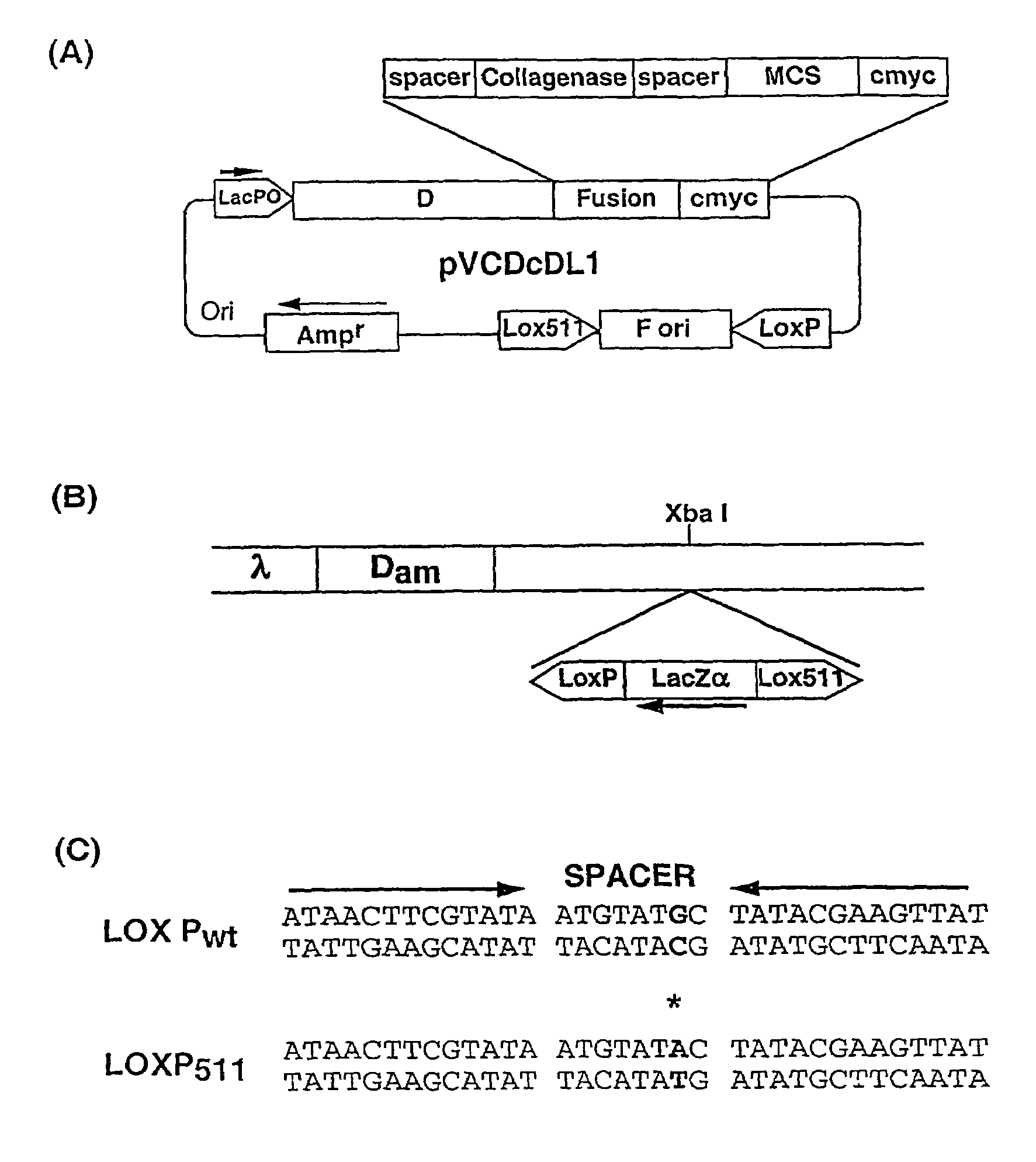Lambda phage display system and the process
a phage and display system technology, applied in the field of new phage display systems, can solve the problems of limiting the library size and the number of clones that can be screened, and the system has not gained much popularity, and achieves high efficiency cloning and high density display of proteins/peptides
- Summary
- Abstract
- Description
- Claims
- Application Information
AI Technical Summary
Benefits of technology
Problems solved by technology
Method used
Image
Examples
example 1
[0057]The system described above is optimized using donor plasmid pVCDcDL1, which expresses D protein fused to a ten amino acid tag, cmyc. pVCDcDL1 was used to transform BM25.8 (Cre+) cells and the transformants were infected with recipient lambda, λDL1. The lysate obtained after culture growth and lysis was plated to obtain ampicillin resistant transductants. These transductants were analysed by PCR to check for integration of plasmid into λ DNA.
[0058]Two kinds of cointegrates were obtained. Single crossover at one of the lox sites resulted in formation of SCO (single crossover cointegrates) which contained the entire donor plasmid and lacZα cassette (FIG. 2). A second crossover event resulted in excision off ori and lacZα cassette and this was called DCO (double crossover cointegrates). Both SCO and DCO produced same number of phages and the display of D-cmyc fusion protein was comparable.
[0059]DcDL1 phages were made and tested for display of D-cmyc in ELISA. Purified DcDL1 phages...
example 2
[0067]The ‘Donor’ plasmid vector pVCDcDL1, (FIG. 1A) a high copy number vector based on pUC119, was constructed for cloning sequences to be displayed as d-fusion protein on. This plasmid vector contains ‘d’ gene of under lacPO followed by a Gly-Ser spacer, collagenase cleavage site, multiple cloning site (MCS) and a decapeptide tag, cmyc. Cloning of DNA sequences in the MCS allows formation of d-fusion protein with the fusion protein present at C-terminus of d protein. The collagenase site allows cleavage of the fusion partner from d protein and is used for elution of bound phages after panning by collagenase treatment. The cmyc tag allows easy identification of the fusion protein. The vector contains M13 phage origin of replication (f ori), flanked by Lox Pwt and Lox P511 sites (Hoess et al., 1982).
[0068]This cassette is extremely stable and there is no loss of ‘f ori’ sequence upon repeated cycles of growth (more than five times) in Cre+ / Cre−host (data not shown).
[0069]pVCDcDL1 wa...
example 3
Comparison of Lambda Display System with M13 Display System
[0075]DNA sequences encoding different length fragments of HIV capsid protein p24 were amplified from pVCp24210 (Gupta et al., 2000) using 5′ primer which annealed to first eight codons of the fragment and contained Nhe I site and 3′ primer which annealed to last eight codons of the fragment and contained Mlu I site. The amplified products were digested with Nhe I and Mlu I and cloned in Nhe I-Mlu I digested, dephosphorylated vector, pVCDcDL1 to create pVCDc(p241)DL1, pVCDc(p246)DL1 and pVCDc(p24)DL1.
[0076]The three constructs were then used to transform Cre+ host BM25.8 and recombination was carried out to obtain Dc(p241)DL1, Dc(p246)DL1 and Dc(p24)DL1.
[0077]DNA encoding different p24 fragments were cloned as Nhe I-Mlu I inserts into gIII display vector, pVC3TA726 (Sampath et al., 1997) and similar gVIII display vector, pVCp2418426 (VKC, personal communication). The recombinants pVC(p241)3426, pVC(p246)3426 and pVC(p24)3426...
PUM
| Property | Measurement | Unit |
|---|---|---|
| density | aaaaa | aaaaa |
| size | aaaaa | aaaaa |
| sizes | aaaaa | aaaaa |
Abstract
Description
Claims
Application Information
 Login to View More
Login to View More - R&D
- Intellectual Property
- Life Sciences
- Materials
- Tech Scout
- Unparalleled Data Quality
- Higher Quality Content
- 60% Fewer Hallucinations
Browse by: Latest US Patents, China's latest patents, Technical Efficacy Thesaurus, Application Domain, Technology Topic, Popular Technical Reports.
© 2025 PatSnap. All rights reserved.Legal|Privacy policy|Modern Slavery Act Transparency Statement|Sitemap|About US| Contact US: help@patsnap.com



